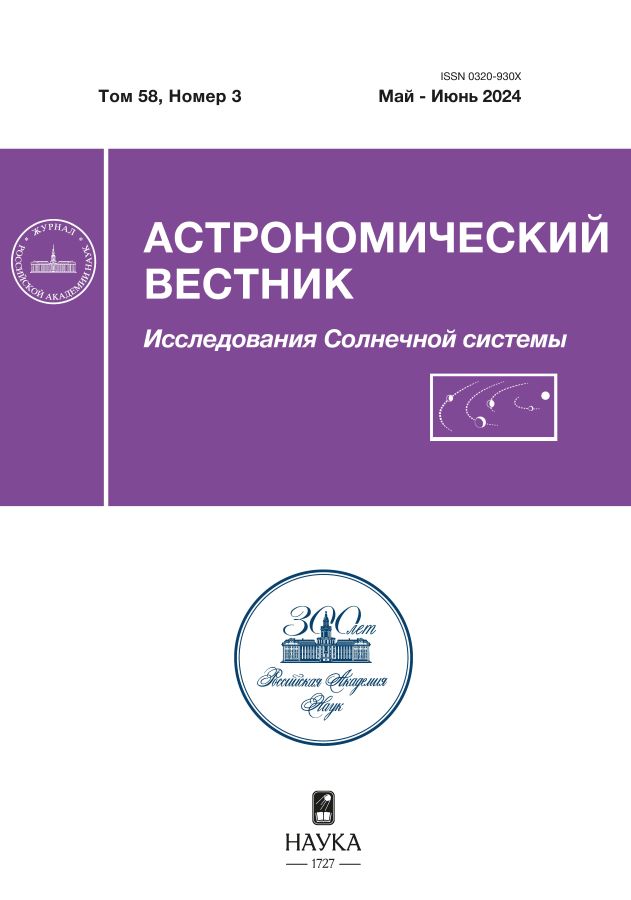Исследование динамики мультиплетов орбитальных резонансов астероидов с малыми перигелийными расстояниями
- 作者: Галушина Т.Ю.1, Летнер О.Н.1, Сюсина О.М.1
-
隶属关系:
- Томский государственный университет
- 期: 卷 58, 编号 3 (2024)
- 页面: 329-336
- 栏目: Articles
- URL: https://ter-arkhiv.ru/0320-930X/article/view/648542
- DOI: https://doi.org/10.31857/S0320930X24030062
- EDN: https://elibrary.ru/NEBRQF
- ID: 648542
如何引用文章
详细
Исследование орбитальных резонансов в динамике астероидов и больших планет имеет важное значение с точки зрения решения проблемы астероидной опасности. В ходе подобных исследований часто возникает необходимость анализа большого числа временных рядов резонансных (критических) аргументов, поскольку для полноты картины необходимо рассматривать не только основной аргумент, но и весь мультиплет. Для работы с мультиплетами нами были разработаны алгоритм и программа классификации поведения резонансного аргумента, которые были применены к изучению динамики резонансных объектов с малыми перигелийными расстояниями. В работе приводятся результаты построения и анализа резонансных мультиплетов для 13 таких астероидов. Исследование показало, что для выявления особенностей резонансного взаимодействия исследуемых астероидов с планетами в большинстве случаев достаточно рассматривать поведение основного критического аргумента. Использование программы автоматизации процесса классификации поведения аргументов значительно сократило временные затраты и вероятность случайных ошибок в процессе обработки полученных данных.
全文:
作者简介
Т. Галушина
Томский государственный университет
编辑信件的主要联系方式.
Email: tatyana.galushina@mail.tsu.ru
俄罗斯联邦, Томск
О. Летнер
Томский государственный университет
Email: tatyana.galushina@mail.tsu.ru
俄罗斯联邦, Томск
О. Сюсина
Томский государственный университет
Email: tatyana.galushina@mail.tsu.ru
俄罗斯联邦, Томск
参考
- Авдюшев В.А. Коллокационный интегратор Lobbie в задачах орбитальной динамики // Астрон. вестн. 2022. Т. 56. № 1. С. 36–46. doi: 10.31857/S0320930X22010017. (Avdyushev V.A. Collocation integrator Lobbie in orbital dynamics problems // Sol. Syst. Res. 2022. V. 56(1). P. 32–42).
- Галушина Т.Ю., Летнер О.Н., Сюсина О.М. Влияние светового давления и эффекта Ярковского на резонансное поведение астероидов с малыми перигелийными расстояниями // Вестн. Томского гос. университета. Математика и механика. 2023. № 85. С. 101–116.
- Гребеников Е.А., Рябов Ю.А. Резонансы и малые знаменатели в небесной механике. М.: Наука, 1978. 128 с.
- Мюррей К., Дермотт С. Динамика Солнечной системы. М.: Физматлит, 2009. 588 с.
- Ellis K.M., Murray C.D. The disturbing function in Solar System dynamics // Icarus. 2000. V. 147. № 1. P. 129–144.
- Gallardo T. Orbital stability in the Solar system for arbitrary inclinations and eccentricities: planetary perturbations versus resonances //Mon. Notic. Roy. Astron. Soc. 2019. V. 487. P. 1709–1716.
- Galushina T. Yu., Letner O.N. Modified version of IDA software and its application to the study of the motion of asteroid 2007 PR10 // Astron. and Astrophys. Transactions. 2021. V. 32. № 4. P. 355–370.
- Li M., Huang Yu., Gong Sh. Assessing the risk of potentially hazardous asteroids through meanmotion resonances analyses // Astrophys. and Space Sci. 2019. V. 364. № 5. id. 78 (12 p.). https://doi.org/10.1007/s10509-019-3557-5
- Murray N., Holman M., Potter M. On the origin of chaos in the asteroid belt // Astron. J. 1998. V. 116. № 5. P. 2583–2589.
- Nesvornу´ D., Morbidelli A. Three-body mean motion resonances and the chaotic structure of the asteroid belt // Astron. J. 1998a. V. 116. № 6. P. 3029–3037.
- Nesvornу´ D., Morbidelli A. An analytic model of three-body mean motion resonances // Celest. Mech. and Dyn. Astron. 1999b. V. 71. P. 243–271.
- Nesvornу´ D., Ferraz-Mello S., Holman M., Morbidelli A. Regular and chaotic dynamics in the mean-motion resonances: Implications for the structure and evolution of the asteroid belt // Asteroids III / Eds: Bottke W.F., Cellino A., Paolicchi P., Binzel R.P. Tucson: Univ. Arizona Press, 2002. P. 379–394.
- Nesvorný D., Roig F. Mean motion resonances in the transneptunian region // Icarus. 2001. V. 150. № 1. P. 104–123. https://doi.org/10.1006/icar.2000.6568
- Sekhar A., Asher D.J., Vaubaillon J. Three-body resonance in meteoroid streams // Mon. Notic. Roy. Astron. Soc. 2016. V. 460. № 2. P. 1417–1427.
- Smirnov E.A. Asteroids in three-body mean-motion resonances with Jupiter and Mars // Sol. Syst. Res. 2017. V. 51. № 2. P. 145–149.
- Smirnov E.A. A new python package for identifying celestial bodies trapped in mean-motion resonances // Astron. and Computing. 2023. V. 43. id. 100707. https://doi.org/10.1016/j.ascom.2023.100707
- Smirnov E.A., Dovgalev I.S. Identification of asteroids in two-body resonances // Sol. Syst. Res. 2018. V. 52. № 4. P. 347–354.
- Smirnov E.A., Dovgalev, I.S., Popova, E.A. Asteroids in three-body mean motion resonances with planets // Icarus. 2018. V. 304. P. 24–30. https://doi.org/10.1016/j.icarus.2017.09.032
- Smirnov E.A., Markov A.B. Identification of asteroids trapped inside three-body mean motion resonances: a machine-learning approach // Mon. Notic. Roy. Astron. Soc. 2017. V. 469. № 2. P. 2024–2031.
- Smirnov E., Shevchenko I.I. Massive identification of asteroids in three-body resonances // Icarus. 2013. V. 222. № 1. P. 220–228.
补充文件












